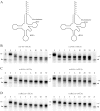Ribonuclease PH plays a major role in the exonucleolytic maturation of CCA-containing tRNA precursors in Bacillus subtilis
- PMID: 15983136
- PMCID: PMC1160522
- DOI: 10.1093/nar/gki675
Ribonuclease PH plays a major role in the exonucleolytic maturation of CCA-containing tRNA precursors in Bacillus subtilis
Abstract
In contrast to Escherichia coli, where all tRNAs have the CCA motif encoded by their genes, two classes of tRNA precursors exist in the Gram-positive bacterium Bacillus subtilis. Previous evidence had shown that ribonuclease Z (RNase Z) was responsible for the endonucleolytic maturation of the 3' end of those tRNAs lacking an encoded CCA motif, accounting for about one-third of its tRNAs. This suggested that a second pathway of tRNA maturation must exist for those precursors with an encoded CCA motif. In this paper, we examine the potential role of the four known exoribonucleases of B.subtilis, PNPase, RNase R, RNase PH and YhaM, in this alternative pathway. In the absence of RNase PH, precursors of CCA-containing tRNAs accumulate that are a few nucleotides longer than the mature tRNA species observed in wild-type strains or in the other single exonuclease mutants. Thus, RNase PH plays an important role in removing the last few nucleotides of the tRNA precursor in vivo. The presence of three or four exonuclease mutations in a single strain results in CCA-containing tRNA precursors of increasing size, suggesting that, as in E.coli, the exonucleolytic pathway consists of multiple redundant enzymes. Assays of purified RNase PH using in vitro-synthesized tRNA precursor substrates suggest that RNase PH is sensitive to the presence of a CCA motif. The division of labor between the endonucleolytic and exonucleolytic pathways observed in vivo can be explained by the inhibition of RNase Z by the CCA motif in CCA-containing tRNA precursors and by the inhibition of exonucleases by stable secondary structure in the 3' extensions of the majority of CCA-less tRNAs.
Figures





Similar articles
-
Endonucleolytic processing of CCA-less tRNA precursors by RNase Z in Bacillus subtilis.EMBO J. 2003 Sep 1;22(17):4534-43. doi: 10.1093/emboj/cdg435. EMBO J. 2003. PMID: 12941704 Free PMC article.
-
Interaction of the 3'-end of tRNA with ribonuclease P RNA.Nucleic Acids Res. 1994 Oct 11;22(20):4087-94. doi: 10.1093/nar/22.20.4087. Nucleic Acids Res. 1994. PMID: 7524035 Free PMC article.
-
Crystal structure of the phosphorolytic exoribonuclease RNase PH from Bacillus subtilis and implications for its quaternary structure and tRNA binding.Protein Sci. 2004 Mar;13(3):668-77. doi: 10.1110/ps.03477004. Epub 2004 Feb 6. Protein Sci. 2004. PMID: 14767080 Free PMC article.
-
A tRNA's fate is decided at its 3' end: Collaborative actions of CCA-adding enzyme and RNases involved in tRNA processing and degradation.Biochim Biophys Acta Gene Regul Mech. 2018 Apr;1861(4):433-441. doi: 10.1016/j.bbagrm.2018.01.012. Epub 2018 Jan 31. Biochim Biophys Acta Gene Regul Mech. 2018. PMID: 29374586 Review.
-
New Insights into the Relationship between tRNA Processing and Polyadenylation in Escherichia coli.Trends Genet. 2019 Jun;35(6):434-445. doi: 10.1016/j.tig.2019.03.003. Epub 2019 Apr 26. Trends Genet. 2019. PMID: 31036345 Free PMC article. Review.
Cited by
-
Nucleotidyltransferase toxin MenT extends aminoacyl acceptor ends of serine tRNAs to control Mycobacterium tuberculosis growth.Nat Commun. 2024 Nov 6;15(1):9596. doi: 10.1038/s41467-024-53931-w. Nat Commun. 2024. PMID: 39505885 Free PMC article.
-
Global Transcriptional Analysis of Virus-Host Interactions between Phage ϕ29 and Bacillus subtilis.J Virol. 2016 Sep 29;90(20):9293-304. doi: 10.1128/JVI.01245-16. Print 2016 Oct 15. J Virol. 2016. PMID: 27489274 Free PMC article.
-
Analysis of tRNACys processing in the absence of CCAase in Bacillus subtilis.Braz J Microbiol. 2019 Jul;50(3):613-618. doi: 10.1007/s42770-019-00075-5. Epub 2019 Apr 12. Braz J Microbiol. 2019. PMID: 31041723 Free PMC article.
-
Small stable RNA maturation and turnover in Bacillus subtilis.Mol Microbiol. 2015 Jan;95(2):270-82. doi: 10.1111/mmi.12863. Epub 2014 Dec 19. Mol Microbiol. 2015. PMID: 25402410 Free PMC article.
-
Comprehensive classification of the PIN domain-like superfamily.Nucleic Acids Res. 2017 Jul 7;45(12):6995-7020. doi: 10.1093/nar/gkx494. Nucleic Acids Res. 2017. PMID: 28575517 Free PMC article.
References
-
- Li Z., Deutscher M.P. Maturation pathways for E.coli tRNA precursors: a random multienzyme process in vivo. Cell. 1996;86:503–512. - PubMed
Publication types
MeSH terms
Substances
Grants and funding
LinkOut - more resources
Full Text Sources
Molecular Biology Databases

